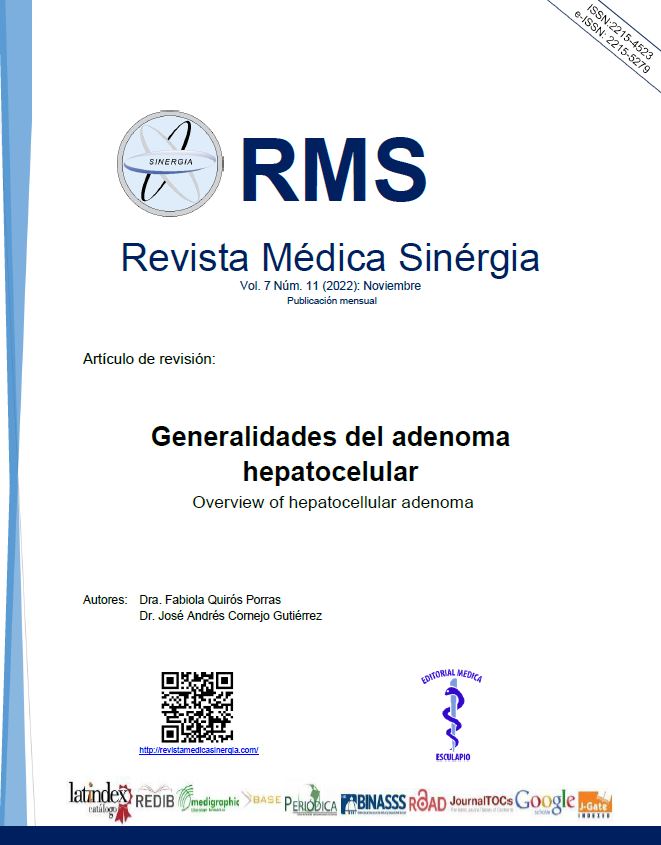Resumen
El adenoma hepatocelular (AHC) es una neoplasia hepática benigna que se desarrolla en un hígado de apariencia normal. Es frecuente en mujeres en edad reproductiva, y puede aparecer de manera esporádica en hombres. Está relacionado con el uso de medicamentos que contienen estrógenos, como los anticonceptivos orales, entre otros factores de riesgo. Por lo general, su presentación clínica es asintomática, y su hallazgo es por pruebas de imagen, la mayoría de veces de forma incidental. Son clasificadas con base en sus características genotípicas y fenotípicas. El manejo se va a dar de acuerdo con la presencia de síntomas, el sexo del paciente, el tamaño de la lesión y su evolución. Pueden presentar complicaciones, como hemorragias intraperitoneales, debido a la rotura del adenoma hepático, lo que puede llevar a una intervención quirúrgica.
Palabras clave
Citas
Townsend. Sabiston textbook of surgery: The biological basis of modern surgical practice. 21st ed. Townsend CM Jr, editor. Filadelfia, PA, United States of America: Elsevier - Health Sciences Division; 2021.
Cameron JL, Cameron AM, editores. Terapias Quirúrgicas Actuales. 13a ed. Elsevier; 2020.
Curry MP, Afdhal NH. Hepatocellular adenoma. Wolters Kluwer Health. 2021 [cited Jan 03, 2022].
Van Rosmalen BV, Furumaya A, Klompenhouwer AJ, Tushuizen ME, Braat AE, Reinten RJ, et al. Hepatocellular adenoma in men: A nationwide assessment of pathology and correlation with clinical course. Liver Int [Internet]. 2021;41(10):2474–84. Doi: https://doi.org/10.1111/liv.14989
Haring MPD, Gouw ASH, de Haas RJ, Cuperus FJC, de Jong KP, de Meijer VE. The effect of oral contraceptive pill cessation on hepatocellular adenoma diameter: A retrospective cohort study. Liver Int [Internet]. 2019;39(5):905–13. Doi: https://doi.org/10.1053/j.gastro.2016.11.042
Rajendiran G. Not All Hepatocellular Adenomas are Caused by the Hormonal Oral Contraceptive. South Dakota Medicine. Jul, 2021;74(7):302-303. Available from: https://pubmed.ncbi.nlm.nih.gov/34449989/
Bioulac-Sage P, Gouw ASH, Balabaud C, Sempoux C. Hepatocellular adenoma: what we know, what we do not know, and why it matters. Histopathology [Internet]. 2022;80(6):878–97. Doi: https://doi.org/10.1111/his.14605
Haring MPD, Cuperus FJC, Duiker EW, de Haas RJ, de Meijer VE. Scoping review of clinical practice guidelines on the management of benign liver tumours. BMJ Open Gastroenterol [Internet]. 2021;8(1):e000592. Doi: https://doi.org/10.1136/bmjgast-2020-000592
Wang X, Zhang X. Hepatocellular adenoma: Where are we now? World J Gastroenterol [Internet]. 2022;28(14):1384–93 Doi: https://doi.org/10.3748/wjg.v28.i14.1384
Klompenhouwer AJ, de Man RA, Dioguardi Burgio M, Vilgrain V, Zucman-Rossi J, Ijzermans JNM. New insights in the management of Hepatocellular Adenoma. Liver Int [Internet]. 2020;40(7):1529–37 Doi: https://doi.org/10.1111/liv.14547
Feldman M, Friedman LS, Brandt LJ, editores. Sleisenger Y Fordtran. Enfermedades Digestivas y Hepáticas: Fisiopatología, Diagnóstico y Tratamiento. 11a ed. Elsevier; 2021.
Yeo CJ. Shackelford’s surgery of the alimentary tract, 2 volume set. 8a ed. Filadelfia, PA, United States of America: Elsevier - Health Sciences Division; 2018.
Nault JC, Blanc JF, Moga L, Calderaro J, Dao T, Guiu B, et al. Non-invasive diagnosis and follow-up of benign liver tumours. Clin Res Hepatol Gastroenterol [Internet]. 2022;46(1):101765. Doi: https://doi.org/10.1016/j.clinre.2021.101765
Mauro E, Forner A. Hepatocellular adenoma in men: Is it time for a precision approach? Liver Int [Internet]. 2021;41(10):2246–8. Doi: https://doi.org/10.1111/liv.15050
Beaufrère A, Paradis V. Hepatocellular adenomas: review of pathological and molecular features. Hum Pathol [Internet]. 2021;112:128–37. Doi: https://doi.org/10.1016/j.humpath.2020.11.016

Esta obra está bajo una licencia internacional Creative Commons Atribución-NoComercial 4.0.
Derechos de autor 2022 Array


